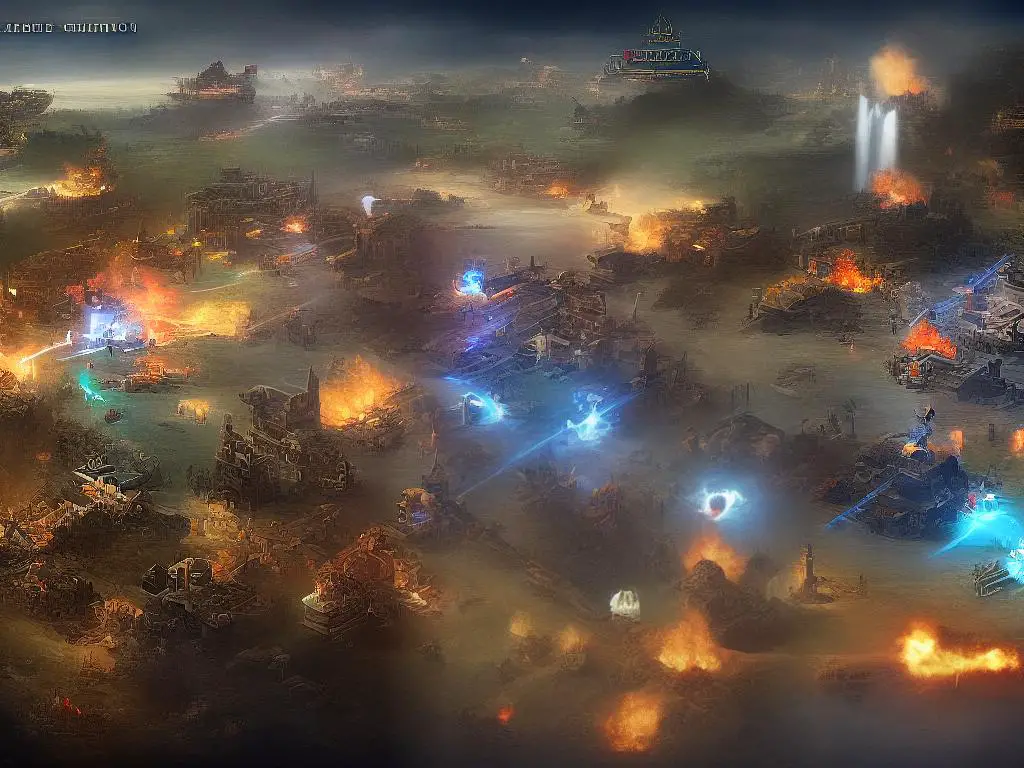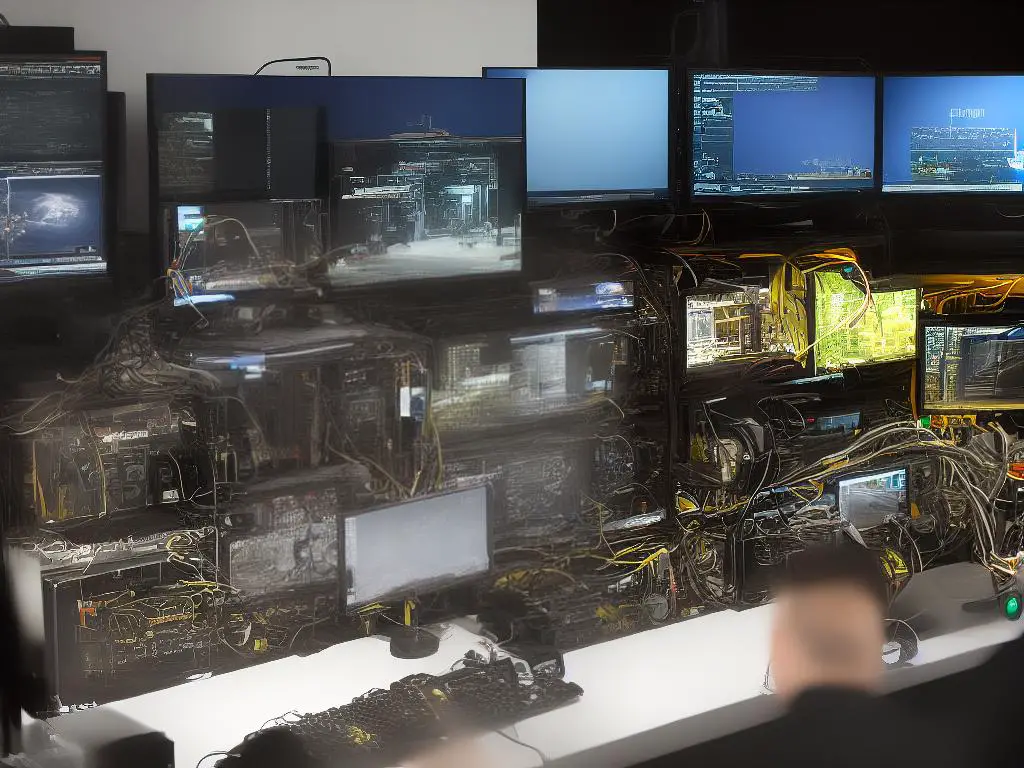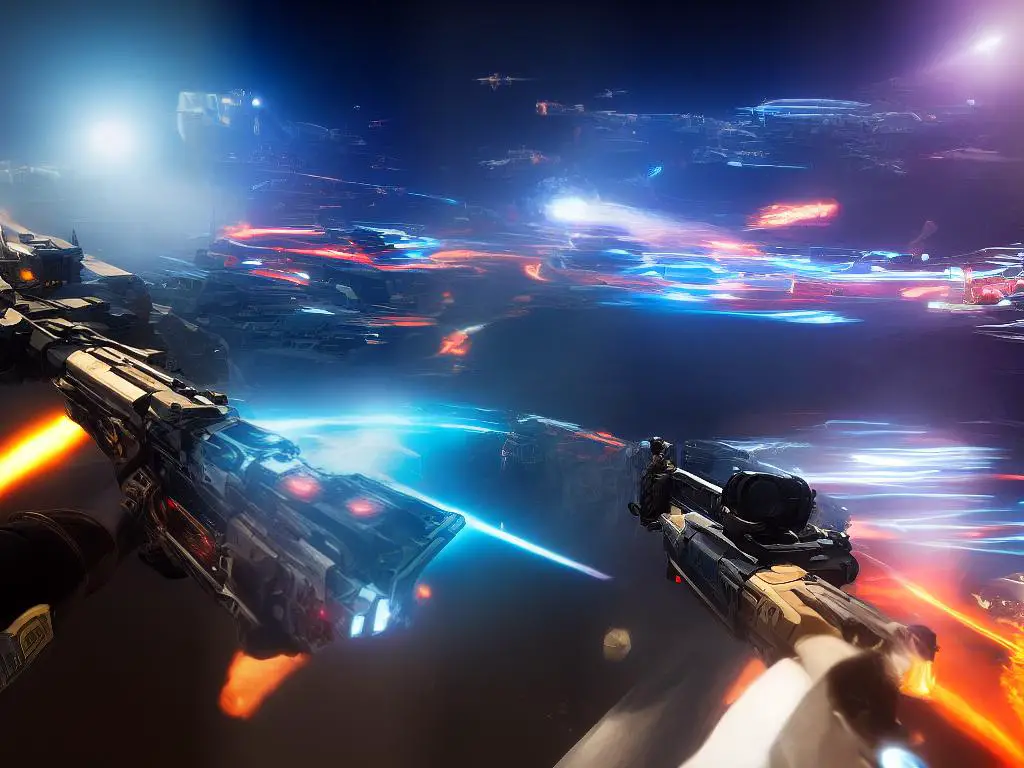The world of gaming has come a long way since its early days, and artificial intelligence (AI) has played a crucial role in shaping its evolution. Artificial Intelligence in Gaming through AgentGPT will be huge.
As games developed from simple simulations into immersive and interactive experiences, AI became a fundamental aspect of game design, enabling the creation of more responsive and intelligent systems.
This article delves into the history, core concepts, tools, and technologies surrounding AI in gaming, touching upon the psychological principles of character creation and exploring ethical considerations, before peering into the exciting future possibilities that AI holds within the gaming industry.
History of AI in Gaming
Table of Contents
- 1 History of AI in Gaming
- 2 Fundamentals of AI in Games
- 3 AgentGPT AI Development Tools and Technologies
- 4 Creating Believable Game Characters
- 5 Procedural Content Generation in Gaming with AgentGPT AI Agent
- 6 AI in Multiplayer Games
- 7 AI and Machine Learning in Game Design
- 8 Ethics and Implications of AI in Gaming
- 9 Future of AI in Gaming
One of the earliest instances of artificial intelligence in gaming can be traced back to the late 1950s with the creation of simple games, such as Tic-Tac-Toe and Chess simulations. As the video game industry grew, so did the complexity and capabilities of AI systems.
Examining seminal titles like 1980’s Pac-Man highlights more advanced AI for its time, as the game featured four different types of enemy behaviors based on the player’s actions. It was around this time that developers increasingly pushed the envelope with experimenting and implementing AI in their games.
The 1990s marked a significant turning point in the history of AI for gaming, as developers began integrating learning algorithms into their games, such as reinforcement learning and neural networks. This period saw the releases of groundbreaking titles like Black & White (2001), a god simulation game developed by Lionhead Studios, wherein AI-controlled creatures could gather resources and interact with the player based on learned behaviors over time.
Major real-time strategy games like StarCraft (1998) featured AI-controlled opponents capable of adapting to the player’s actions and altering tactics accordingly, demonstrating a rapidly growing trend of increasingly sophisticated AI applications in gaming.
Advancements in AI continued into the 2000s, with notable titles like F.E.A.R. (2005) featuring more dynamic and realistic enemy AI. In Half-Life 2 (2004), AI-driven non-player characters exhibit context-driven and emotive capabilities, understanding the environment and reacting to it, as well as the player’s actions. This era provided gamers with a more immersive experience, instilling the importance of AI in shaping the future gaming landscape.
The 2010s ushered in a new wave of AI development, with cloud-based technology playing a crucial role in improving the efficiency and capabilities of AI systems. Machine learning and deep learning techniques have given rise to sophisticated game AI, enabling developers to tailor the gaming experience even further.
In games like The Witcher 3: Wild Hunt (2015), NPC behaviors are adaptable and responsive, showing the immense impact that evolving AI technologies have had on game design.
In recent years, AI approaches in gaming have expanded beyond character behavior to include procedural content generation and personalization.
For instance, No Man’s Sky (2016) features a procedurally generated universe with over 18 quintillion planets, each filled with unique flora and fauna created through AI algorithms. Similarly, AI-driven virtual assistants like Ubisoft’s Sam help tailor gaming experiences by offering individualized recommendations based on player preferences and data.
The continuous advancements in AI technologies and their diverse applications in gaming consistently push the boundaries, ensuring the delivery of innovative, immersive, and engaging experiences as the industry progresses.

Fundamentals of AI in Games
One of the fundamental concepts of AI in gaming is pathfinding, which involves determining the most efficient route for a character or object to reach a specific destination. This is crucial for achieving realistic movement of characters within the game world.
A popular algorithm for pathfinding is the A* (A-star) algorithm, accounting for factors such as terrain, distance, and obstacles in its calculations. Other algorithms, like Dijkstra’s and the Floyd-Warshall, can also be employed, depending on the intricacy of the game environment and the desired level of realism. As AI technologies advance, we can expect a seamless integration of these concepts, further enhancing the gaming experience and pushing the limits of what gaming can achieve.
Another essential concept in-game AI is decision-making. AI characters must make decisions based on their current state, the world state, and their goals. To achieve sophisticated decision-making, designers can employ different paradigms and techniques, such as Finite State Machines (FSM), Goal Oriented Action Planning (GOAP), utility-based systems, or even learning algorithms like reinforcement learning.
Depending on the game’s complexity and the desired behaviors, a designer may choose to combine multiple techniques to design a more robust and flexible AI decision-making system.Behavior trees are another fundamental concept within AI for gaming. A behavior tree is a hierarchical structure consisting of nodes that define different actions, decisions, and states for AI characters in a game.
They help in creating complex and dynamic behaviors by decomposing tasks into subtasks and organizing them in a tree-like structure. Each node in the tree can be a simple action (like moving or shooting), a decision-making process, or another sub-tree with further actions and decisions.
The execution of the AI character’s behavior starts from the root node and traverses down the tree until an action is executed or the node fails.In addition to the concepts mentioned above, various AI techniques can be applied in gaming.
These include machine learning, which can be used to train AI characters to adapt and improve their performance in gameplay (for example, learning the player’s habits and adjusting the AI’s strategy accordingly). Another technique, natural language processing, can be used to design in-game dialogues, where AI characters can interact with players or other characters in a more realistic and human-like way.
Furthermore, AI can play a significant role in procedurally generating game content. Procedural content generation (PCG) allows for the creation of unique game environments, levels, and characters, as well as providing a fresh experience for players in each playthrough.
AI algorithms can analyze the player’s style and actions, then use this information to generate content tailored to the player’s preferences and skill level. Additionally, AI-driven PCG can help developers save time and resources by automating the generation of complex game worlds and assets.

AgentGPT AI Development Tools and Technologies
Moving on to the subject of game engines, Unity is one of the most popular choices for AI development in gaming. As a well-established game engine, Unity supports a wide range of platforms and offers a variety of built-in tools and assets for AI.
This makes it an ideal choice for both beginners and seasoned developers. With Unity’s advanced AI capabilities, developers can create complex and realistic game environments with customizable AI characters. The component-based system within Unity allows developers to easily implement AI behaviors, pathfinding, and decision-making systems, such as the Unity Navigation System, which provides efficient pathfinding and obstacle avoidance.
Another popular game engine that is widely used for AI development in gaming is the Unreal Engine. Developed by Epic Games, Unreal Engine provides a powerful and robust set of AI tools that allow developers to create intelligent characters with lifelike behaviors.
Unreal Engine’s visual scripting language, Blueprint, makes it easy to implement AI features without writing a single line of code, making it accessible to developers lacking programming expertise. The engine’s built-in tools like the Behavior Tree and the Navigation Mesh enable developers to add intricate AI behaviors and efficient navigation to the game characters.
TensorFlow, an open-source machine learning library developed by Google, can also be used for AI development in gaming. TensorFlow provides a flexible and efficient platform for developers to train and test AI models. While it is not specifically built for game development, TensorFlow can be integrated with popular game engines like Unity and Unreal for enhanced AI development.
For example, ML-Agents, a toolkit offered by Unity, allows developers to utilize TensorFlow for creating more intelligent and adaptive characters in games. By incorporating TensorFlow, developers can leverage the power of machine learning to improve character behaviors and create more challenging and engaging gameplay experiences.
In addition to the aforementioned game engines and libraries, there are several other AI tools and resources available for game developers. For instance, OpenAI is an organization that provides cutting-edge AI research and offers various tools and resources for AI development, including their popular invent, which allows the creation of human-like AI characters. Other resources, like the AI Game Programmers Guild, provide a community and support network for developers interested in AI-related research and innovation in the gaming industry.
Reinforcement learning (RL) is a rapidly growing approach within AI development for gaming, enabling agents to learn through trial and error to maximize successful outcomes in achieving specific goals. There are various RL algorithms and libraries available for game developers to experiment with, such as OpenAI’s Gym, a toolkit designed to provide a series of environments for benchmarking and testing RL algorithms.
By exploring these tools and technologies, enthusiasts, hobbyists, and skilled developers can introduce innovative AI solutions into their games, creating immersive and engaging gameplay experiences for players.

Creating Believable Game Characters
To further enhance AI-driven gaming experiences, it is essential to understand the psychological principles behind character design. By focusing on characters’ reasoning, emotions, and motivations, developers can effectively bring them to life in a realistic and convincing way.
This understanding is especially crucial when developing AI-powered characters, as they need to intelligently respond to player inputs and dynamically evolve their personality and behavior throughout the gameplay experience. In combination with reinforcement learning advancements, achieving this level of character design will result in more immersive and compelling games for players to enjoy.
When designing the reasoning capabilities for your game characters, it’s essential to establish a cohesive logical framework for them to follow.
The AI algorithms powering your game characters should be able to analyze their environment, recognize patterns, infer information from past experiences, and make informed choices in real-time. Additionally, their reasoning processes should not only dictate their actions, but also their goals, values, and attitudes, making their personalities more complex and nuanced.
Emotional resonance is another crucial factor in creating convincing game characters. Emotions drive behavior and can be used to tell a captivating story or create a memorable moment for players. By integrating emotional aspects into the AI programming, game characters will possess dynamic emotional states that influence their actions and reactions.
A well-designed AI should enable its characters to communicate and express their emotions using facial animations, gestures, and speech. This not only enhances the realism of the characters but also creates a more immersive gameplay experience for the players.
Additionally, your game characters should have well-defined and believable motivations, which determine their decision-making processes and how they interact with other characters and the game world. Motivations can range from simple survival instincts to complex desires and values, which shape their decisions and help players empathize with the characters.
AI algorithms and decision trees should be designed in a way that takes the character motivations into consideration while making decisions, delivering a consistent behavior that aligns with the character’s backdrop and personality.
An important aspect of creating realistic characters in gaming is ensuring they interact with other characters, the game environment, and are affected by the player’s actions and choices. When designing AI-controlled characters, their actions should evolve and adapt based on the relationships they develop and the changing circumstances of the game world.
This not only provides an engaging experience for players but also creates believable game characters that feel real and captivating.

Procedural Content Generation in Gaming with AgentGPT AI Agent
Incorporating procedural content generation (PCG) into gaming can further enhance these engaging experiences. PCG employs algorithms to produce unique, adaptive, and varied game content, such as levels, textures, maps, characters, and narratives.
Unlike static or predetermined content, PCG harnesses the power of artificial intelligence to create dynamic and engaging environments. This innovative technique generates diverse and potentially infinite game worlds, enhancing gameplay and reducing the workload of game designers who would otherwise need to create assets and content manually.
In gaming, several PCG methods have been widely used to create different types of content. One popular method is the use of fractal algorithms, which are particularly effective at generating natural-looking terrain, textures, and scenery.
Another method is cellular automata, which provide complex and lifelike environments via simple, rule-based interactions between adjacent grid cells. Additionally, genetic algorithms are employed to produce optimized and visually appealing game assets by simulating evolutionary processes like mutation and selection.
Procedural content generation also plays a crucial role in the realm of AI-driven game design. For instance, artificial neural networks and machine learning algorithms have been employed to develop coherent and emergent narratives in games by analyzing and molding player choices and reactions. Moreover, AI-driven character generation can effectively combine PCG techniques with player modeling, resulting in responsive and authentic non-player characters (NPCs) that adapt to different gaming situations and styles.
Some popular games have employed procedural content generation to great effect. For example, Minecraft relies heavily on PCG for its terrain generation, which plays a major role in the game’s enduring appeal. The space exploration game No Man’s Sky applies PCG techniques across numerous aspects such as planetary terrains, ecosystems, spacecraft, and even alien species. In the roguelike genre, PCG ensures that each playthrough is unique and challenging by generating diverse levels, items, enemies, and encounters.
Procedural content generation in AI for gaming creates a deeply engaging and dynamic gaming experience by developing rich, varied, and evolving game worlds that adapt and respond to the player’s actions. As advancements in artificial intelligence and machine learning continue, the potential for producing entirely AI-driven game design holds remarkable promise. This allows developers to craft games that are tailored to the player’s own imagination, creativity, and autonomy, making gameplay experiences truly unique and captivating.

AI in Multiplayer Games
Moreover, Artificial Intelligence (AI) plays a crucial role in multiplayer games, ensuring a more balanced and enjoyable gaming experience for human players. One key aspect of AI in such games is to balance the skill levels of players by employing techniques like matchmaking, where individuals are paired based on their skill level or game experience.
AI algorithms analyze each player’s performance, game history, and other relevant metrics to create these well-matched pairings. As a result, this maintains a challenging and enticing environment for all players, minimizing uneven matches and keeping gamers motivated and engaged.
Another notable application of AI in multiplayer games is the creation of bots, which are non-player characters controlled by AI. Bots are typically used to fill in gaps when there are not enough human players or to replace disconnected players during matches, ensuring uninterrupted gameplay.
They can be programmed to mimic human behavior or follow predetermined strategies, adding diversity and complexity to the game. Bots can be customized to simulate various skill levels, making them an ideal tool for training new players or providing a challenging opponent to more experienced gamers.In multiplayer gaming environments, AI is also employed to enhance the overall gaming experience for human players by dynamically adjusting the in-game elements.
This can include tasks such as modifying the difficulty of challenges or altering the behavior of non-player characters to suit the players’ skill levels. These AI-driven adjustments enable players to progress at their own pace while still experiencing a challenging and engaging gaming environment.
Apart from these applications, AI is also used to monitor player behavior in online multiplayer games, identifying and banning cheaters or hackers who manipulate the game’s mechanics for an unfair advantage. Advanced AI-driven systems can track and analyze patterns in player behavior, game performance, and resource management to detect and deter such dishonest practices.
This ensures a fair playing field for all players, maintaining the integrity of the gaming experience.
Artificial Intelligence is constantly evolving, and as it progresses, multiplayer games are set to benefit immensely from its ability to create more immersive, dynamic, and personalized experiences for players. AI-powered analytics can also be utilized to collect players’ feedback and preferences, allowing game developers to fine-tune game mechanics and deliver targeted content that caters to players’ tastes.
As AI for gaming continues to grow stronger, it is anticipated to bring the multiplayer gaming landscape to new heights of user engagement and enjoyment.

AI and Machine Learning in Game Design
Reinforcement learning and neural networks are two prominent machine learning techniques that are instrumental in developing cutting-edge AI for gaming. These methods have the potential to revolutionize game design by creating intelligent agents, enhancing player experiences, and enabling complex decision-making within games.
Reinforcement learning enables AI agents to learn winning strategies through a trial-and-error process, while neural networks are designed to mimic the way the human brain functions, assisting AI agents in adapting and excelling in various gaming situations.
AI advancements have effectively improved non-playable character (NPC) behavior in video games. With reinforcement learning, NPCs learn to make complex decisions based on their prior experiences in the gaming environment, leading to more engaging and intuitive gameplay.
For example, Google DeepMind’s AlphaGo AI has displayed its prowess in the ancient board game of Go. Implementing a combination of neural networks and reinforcement learning, AlphaGo was able to defeat World champion Go player Lee Sedol, demonstrating the potential of AI strategies in gaming.
Neural networks have also led to breakthroughs in AI-driven elements in games. These networks can analyze extensive amounts of data and adapt their performance as they learn from experience. This adaptability assists in optimizing game difficulty and balance, ensuring that players consistently encounter an engaging challenge.
For instance, AI-driven characters can learn from players’ actions, becoming more formidable opponents as their skills improve over time.
Virtual reality (VR) game design has similarly benefited from neural networks and reinforcement learning techniques. Developers can train machine learning algorithms on vast datasets of human movement and physics simulations, enabling them to create more realistic and immersive experiences for players.
One successful implementation is the AI-driven enemies in the VR game Robo Recall. The machine learning system recognizes player’s movements, allowing the robots to dodge, block, or counteract those movements, providing a dynamic and engaging experience for the players.
The incorporation of AI and machine learning in game design is not limited to direct gameplay applications. In-game animation, for example, can be significantly improved through the use of machine learning algorithms. These algorithms can generate realistic animations while may reduce development costs and time. AI-driven procedural content generation can also create diverse, engaging worlds that adapt in real-time to player behaviors.
Artificial Intelligence (AI) and machine learning techniques, such as reinforcement learning and neural networks, have become increasingly prevalent in the gaming industry, revolutionizing game design and overall player experience. These advancements hold the potential to transform gaming experiences, offering more intelligent NPCs or immersive VR environments. As AI continues to progress, enthusiasts and hobbyists can look forward to an exciting future for gaming experiences heavily influenced by machine learning.

Ethics and Implications of AI in Gaming
In recent years, developers and hobbyists alike have leveraged AI to push the boundaries of gameplay, graphics, and overall user experience. However, as AI becomes an integral part of the gaming world, it is essential to address ethical considerations and potential implications that may arise. A key area of concern is the protection of user privacy.
AI-powered systems can gather vast amounts of user data, making it crucial for gaming companies to strike a balance between leveraging this information for improved experiences while safeguarding player privacy and ensuring ethical practices remain at the forefront of AI innovations within the gaming sphere.
Another significant aspect of ethics in AI for gaming revolves around the potential for addiction. Gaming addiction has long been a point of concern, but the integration of AI could exacerbate the issue. Sophisticated AI algorithms could lead to more engaging and immersive gaming experiences, making it more difficult for vulnerable players to resist the allure of video games.
Developers, in this case, have a moral responsibility to consider how their AI-powered creations could influence susceptible users and contribute to gaming addiction.In addition to these ethical considerations, the increasing use of AI in gaming may also have potential job implications. As the industry shifts from employing traditional game developers and designers to embracing AI-driven processes, workers may be displaced by automated systems.
There is a need for the gaming industry to recognize the impact of AI on the job market and find ways to retrain or transfer the skills of employees in transition. Ensuring the sustainability of the workforce will be crucial as AI for gaming continues to evolve.
Ethics also come into play when considering the impact of AI on the representation of various groups within gaming. For example, AI-generated characters have the potential to reinforce stereotypes and biases present in the underlying models, affecting the way players perceive and interact with characters. In this context, it becomes vital for developers to consider the ethical implications of using AI in character design and storytelling, ensuring fair and accurate representation of diverse groups to prevent perpetuating negative stereotypes.
The debate surrounding the concept of accountability in AI for gaming raises important ethical questions. In traditional gaming, designers and developers are often held responsible for the content of their games. However, when AI-generated elements or characters contribute to outcomes that may be ethically questionable, it becomes difficult to attribute blame.
As AI continues to permeate the gaming realm, it is essential for engineers, developers, and society as a whole to engage in conversations about ethical responsibility and the potential implications of AI-generated applications in the world of gaming.

Future of AI in Gaming
The gaming industry thrives on groundbreaking innovation, and as technology rapidly progresses, AI integration in gaming is becoming increasingly prevalent. In this near future, gamers can look forward to immersive and personalized experiences powered by AI, which will open doors to a world of new gaming opportunities that were previously uncharted territories.
The seamless merging of these two paragraphs highlights the importance of ethical considerations in AI’s role within gaming, while also showcasing the exciting new prospects it brings to the table.
One of the most intriguing advancements in AI for gaming is the advent of adaptive game mechanics. This development will revolutionize the gaming landscape by tailoring game difficulty, pace, and storyline to individual players. As AI learns an individual player’s preferred style, preferences, and skill level, it can adapt gameplay to create a custom experience. This level of personalization can engage players on a much deeper level, ensuring that they are consistently challenged and entertained according to their preferences.
Player-driven storylines and dynamic in-game characters are another exciting trend emerging within the AI gaming realm. Developers have begun to create non-playable characters (NPCs) that possess complex personalities and can hold meaningful interactions with players.
These NPCs can adapt, learn, and make decisions based on the player’s actions, fostering an emotionally charged connection that elevates real-time storytelling. This groundbreaking leap in gaming allows for a unique experience each time a game is played, providing endless replay value.
AI is also providing game developers with the tools to build sophisticated, procedurally generated worlds. Procedural generation, powered by AI, can auto-create intricate and expansive environments without the need for extensive hand-crafting by designers.
This enables the production of larger, more realistic game environments in less time. Furthermore, AI-driven procedural generation can offer limitless variations in scenery, challenges, and characters, setting new standards for the kind of engaging, immersive experiences players can expect.Another promising trend to emerge will capitalize on the idea of using AI as a creative collaborator in game design. AI algorithms could be used to create compelling characters, thought-provoking narratives, and innovative gameplay mechanics. Developers can harness the potential of AI to assist in generating fresh ideas that complement human creativity, revolutionizing how games are conceived and designed.
In conclusion, the future of AI in gaming is bright and full of potential, as it is poised to usher in a new era of gaming experiences that will continuously marvel and captivate players. The integration of AI will only continue to improve existing gaming options and craft unique adventures, ultimately pushing the boundaries of what is possible within the gaming realm.

As we have seen throughout the essay, the impact of AI in gaming is immense and ever-evolving. The advancements in AI development are not only enhancing gameplay experiences for players, but also pushing the boundaries of what game designers can achieve.
With ongoing research and technological progress, we can anticipate newer applications for AI within multiplayer settings, as well as continued advancements in procedural content generation and machine learning-based design.
As we embrace these developments, it remains important to consider the ethical implications and challenges that come with this powerful technology, ensuring that the expansion of AI in gaming continues to contribute positively to our entertainment and the many virtual worlds we immerse ourselves in.

I’m Dave, a passionate advocate and follower of all things AI. I am captivated by the marvels of artificial intelligence and how it continues to revolutionize our world every single day.
My fascination extends across the entire AI spectrum, but I have a special place in my heart for AgentGPT and AutoGPT. I am consistently amazed by the power and versatility of these tools, and I believe they hold the key to transforming how we interact with information and each other.
As I continue my journey in the vast world of AI, I look forward to exploring the ever-evolving capabilities of these technologies and sharing my insights and learnings with all of you. So let’s dive deep into the realm of AI together, and discover the limitless possibilities it offers!
Interests: Artificial Intelligence, AgentGPT, AutoGPT, Machine Learning, Natural Language Processing, Deep Learning, Conversational AI.




